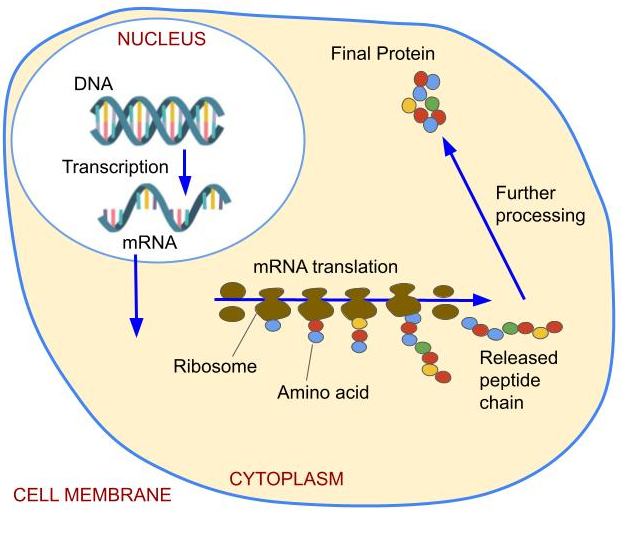A-to-I mRNA Editing | 21 May 2025
Why in News?
Researchers from China highlighted the process of A-to-I mRNA editing, especially in the wheat pathogen Fusarium graminearum, revealing its complex role in biology.
What is A-to-I mRNA Editing?
- DNA: DNA (Deoxyribonucleic acid) is the genetic material of organisms and has a double helix structure. It is composed of four nucleotides: adenine (A), thymine (T), cytosine (C), and guanine (G), which pair specifically (A with T, and C with G).
- The sequence of these bases carries the instructions for making proteins and Ribonucleic acid (RNA).
- Messenger RNA (mRNA): It is a type of single-stranded RNA that plays a key role in protein synthesis. It is created from DNA during the process of transcription.
- mRNA acts as a messenger by carrying genetic instructions from the DNA in the cell’s nucleus to the cytoplasm, where proteins are made.
- In the cytoplasm, the cell’s protein-making machinery (mainly ribosomes) reads the mRNA sequence.
- Each set of three bases (called a codon) corresponds to a specific amino acid. These amino acids are then linked together to form proteins, which perform essential functions in the body.
- A-to-I mRNA Editing: It is a biological process where the nucleotide adenosine (A) in messenger RNA (mRNA) is enzymatically converted to inosine (I).
- The editing is performed by enzymes called ADARs (Adenosine Deaminases Acting on RNA).
- Impact on Protein Synthesis: Inosine as result of A-to-I mRNA Editing is read as guanine (G) by ribosomes during translation, potentially altering the amino acid sequence of proteins.
Note: Transcription is the process of making an RNA copy of a gene’s DNA sequence. Translation, in genomics, is the process by which the information encoded in messenger RNA (mRNA) directs the addition of amino acids during protein synthesis.
How Does RNA Editing Compare to DNA Editing?
- RNA Editing: It is the process of correcting mistakes in messenger RNA (mRNA) after it has been synthesized from DNA but before it directs protein production.
- This process allows cells to produce normal, functional proteins despite errors in the mRNA sequence.
- RNA Editing Vs. DNA Editing: RNA editing causes temporary changes to the RNA, unlike DNA editing which permanently alters the genome.
- This temporary nature allows doctors to halt therapy if adverse effects arise, reducing long-term risks.
- RNA editing relies on ADAR enzymes naturally found in the human body, lowering the chance of immune reactions compared to DNA editing tools that use bacterial proteins.
- RNA editing is therefore potentially safer for repeated treatments and for patients with immune sensitivities.
UPSC Civil Services Examination, Previous Year Questions (PYQs)
Q1. With reference to agriculture in India, how can the technique of ‘genome sequencing’, often seen in the news, be used in the immediate future? (2017)
- Genome sequencing can be used to identify genetic markers for disease resistance and drought tolerance in various crop plants.
- This technique helps in reducing the time required to develop new varieties of crop plants.
- It can be used to decipher the host-pathogen relationships in crops.
Select the correct answer using the code given below:
(a) 1 only
(b) 2 and 3 only
(c) 1 and 3 only
(d) 1, 2 and 3
Ans: (d)

